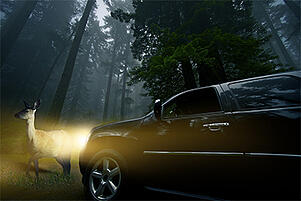 Fall is an excellent time of year for those who live in the Midwest. Football has returned, the temperatures are comfortable, and watching the leaves change colors is enjoyable.
Fall is an excellent time of year for those who live in the Midwest. Football has returned, the temperatures are comfortable, and watching the leaves change colors is enjoyable.
Unfortunately, this is also the peak time of year for deer and auto collisions. Mating season for deer runs from October through December, so the population is more active during this time, accounting for that increase in crashes.
Here are some tips to prevent collisions between your car and a deer this fall.
1. Pay attention to your surroundings.
Look for the yellow traffic sign with a deer on it. If you see one, you’re entering an area with an active, concentrated deer population. Make sure your eyes are constantly moving, and pay particular attention to the side of the road.
And don’t forget to pay attention to what other cars are doing. The car in front of you may brake suddenly. If you notice something out of the ordinary, slow down.
2. One deer probably equals many more.
Deer usually travel in herds, so if you see one cross the road, look immediately to where the deer came from. There are probably others ready to cross. Deer are most active between 6:00 and 9:00 p.m.
3. High beams, high beams, high beams.
Use your high beams as much as oncoming traffic will allow at this time of year. High beams do a great job lighting up the road in front of you, especially the side where the herd may be hanging out.
If you feel your headlights aren’t lighting up the road adequately, consider taking your car to your local mechanic for a check-up. A headlight may be burned out or need an adjustment.
4. Never swerve for a deer or other animal.
While swerving is an instinct many of us feel when an animal runs in the road, it can put us in a more dangerous situation. Swerving can cause you to lose control of your car, put you in the lane of oncoming traffic, or cause you to hit a tree or ditch and overturn your vehicle. The best techniques are to remind yourself not to swerve and to brake firmly.
5. Consider purchasing deer whistles.
While there is conflicting data on whether deer whistles work, they’re a cheap precaution. I believe it’s worth giving them a try.
6. Stay calm and safe.
If you hit a deer, another instinct is to get out of your car to check the damage. But can you determine the extent of the damage just by looking at it? Probably not. I recommend you stay in your car. From there, you can do several things that will keep you and your family safe:
a. Call 911;
b. Turn on your hazard lights;
c. Call your insurance company; and
d. Call roadside assistance if you have it.
7. Knowledge is power.
Please make sure you understand your auto insurance policy's coverages and insurance limits. Comprehensive insurance covers damage from hitting an animal; however, you'll be left with the bill if you don’t have this coverage.
Talk to your local independent insurance agent to learn more.
Do you have any suggestions or information you’d like to share? I’d love to hear from you. Please share them in the box below.
This article is intended for general educational and illustrative purposes only and should not be construed to communicate legal or professional advice. Further, this article is not an offer to sell insurance. Please consult with your licensed insurance agent for specific coverage details and your insurance eligibility. All policies are subject to the terms, conditions, limitations, definitions, and exclusions contained therein.





